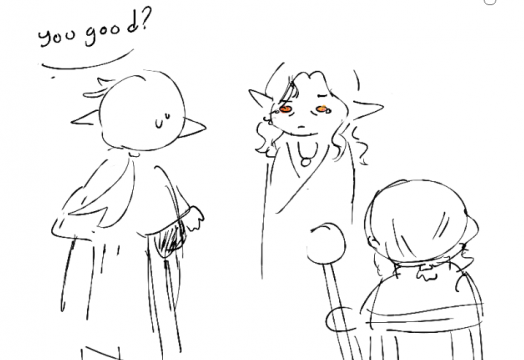-
Posts
1028 -
Joined
-
Last visited
Content Type
Profiles
Personas
Wiki
Rules
War
Systems
Safety
Player Conduct
Forums
Forms
Posts posted by z3m0s
-
-
"T'is a shame. . . The followers of Xan seem ever eager to lose all they have at the hands of bad manners. Such great burdens cannot overshadow the simplicities of life. . . For how can you expect a man to die for your cause if you'd not even pretend to stand beside him." croaked an ancient figure high atop the throne of the world, letting out a long sigh and a faint shaking of his head as he sat idle, watching onward as he toiled away at various projects of ingenuity, all the while chuffing on the harshest Aegis skunk he could conjure from the depths of his voidal pockets.
2 -
Can you get ferries working again? That'd help a lot
P.S: Skills or death
0 -
Spoiler
Arcadia coming soon
3 -
5 hours ago, alexmagus said:
I'd have to say the OOC scheming and major toxicity within nations? Idk how you'd adapt that to a Netflix show, but it needs to be added!
I always thought the OOC aspects of the server would make for incredibly detailed narratives were they adopted into the "rp" as well, because I think in a sense it is inherently intertwined.
For something "OOC" like a netflix adaption yeah I think the OOC aspects would be just as fascinating as the RP timeline.1 -
 Spoiler
SpoilerThere is two spaces under Yol Zahkrii between A and herald.
6 -
Can you do a /d20 bind so I can assign it to W 🥴
SpoilerVery cool, great work homie! Keep it up 🙏
2 -
-
I'd love to see Displacement more +1
3 -
Perfect timing, I actually just finished my new PC setup!
Spoiler 1
1 -
An ancient dwarfs flaming blue gaze widened suddenly as his attention landed upon the symbol atop the letter, the likes of which he hadn't seen in centuries. . . His motions fell still as he reminisced on old times, what once was and what could have been. . . Then he ate a chocolate egg for some reason and moved on with his life.
1 -
+1 but why is it even 3 compared to 1? I probably should know, but is it it a lore reason?
1 -
This read like "NEXT TIME ON APOTHEOSIS" and I love that.
7 -
-
GLORIOUS PURPOSE
 0
0 -
50 minutes ago, Samler said:
Seemsabitwierd, 'theyhaveorcstrengthbutnotorcstrength!' Whynotbecomparabletotigerkha? Betweenorcandhumanstrength.
Regardless of the validity of the amendment, I think its a good call to keep things standardized strength wise, even Palelords are compared to Ologs in strength. Seems like if they're just a bit weaker than a peak orc, makes sense to me.
0 -
Absolute power corrupts absolutely
22 -
Spoiler

MC Name: z3m0s
Character's Name: Kalgrimmor
Character's Age: Ancient
Character's Race: Dwarf
Link to your accepted MA: https://www.lordofthecraft.net/forums/topic/177490-maarcane-z3m0s/
What magic(s) will you be teaching? Sensory Illusion
Describe this magic or a creature as a whole:
Sensory Illusion, or the Art of Perception, manipulates the Void to create sensory deceptions without physical impact, focusing on visual and auditory illusions. It's an intricate art requiring the illusionist's firsthand experience with the sensations they wish to replicate. This magic doesn't allow for direct mind control but influences perceptions based on the caster's skill and the target's nature.
Learning this art demands years, with emphasis on understanding both the physical realm and mental intricacies. Mastery involves starting with basic glamours and advancing to complex, multi-sensory figments, highlighting the importance of believability and the illusionist's experience.
Sensory illusion, while flexible, has its boundaries and rules. It can't physically alter reality, only perceptions. The creator's concentration and the illusion's believability are crucial; any slip can shatter the illusion. Creators must also have visual contact with their target and cannot perceive their own illusions, relying on their knowledge of the sensation being imitated. Ethical use is vital to prevent misuse, emphasizing the importance of disciplined practice in this magical domain.
Are there different sections or subsections of magic? Can those be elaborated upon?
Sensory Illusion itself is a specialized subsection of arcane magic, focusing on the manipulation of the Void to create illusions that influence the senses. It is divided further into:
- Glamours: Alterations of sensory perceptions regarding existing objects. These changes can involve sight, sound, smell, touch, or taste, but do not create new objects; rather, they modify perceptions of what's already there.
- Figments: The creation of entirely illusory objects or sensations from nothing. These are not simple modifications but rather entirely fabricated experiences planted into the minds of targets.
- Enchantments: Special applications of illusion magic that involve embedding illusions into objects or beings for a duration, altering perceptions or appearances more persistently.
Can you give an example of a casting emote, of a spell of your choice?
Kalgrimmor’s gaze pierces the veil of the ordinary, reaching into the depths of the void. His hands move with precision, tracing unseen symbols in the air as he establishes a link to the arcane energies. “Observe, Ordar,” he murmurs, his voice a blend of concentration and instruction. “The key is not just to imagine, but to believe in the reality of your illusion.”
With the void now attentive to his will, Kalgrimmor envisions a spider, large and bristling with thick, dark hair. He imagines each leg moving independently, its eyes glistening with a predatory gaze. He holds the image firm in his mind's eye, then gently pushes this perception towards Ordar, weaving it through the interconnected web of magic that binds mage to target.
Ordar, for his part, waits with bated breath, his eyes widening as he perceives the illusion. A gasp escapes him as his form jumped faintly, letting out a sigh of relief after the initial shock of eyeing the spider lurking nearby. “Incredible...” he breathes out, a mixture of awe and a hint of shock coloring his tone.
“Not real, but convincing, yes?” Kalgrimmor says with a slight smile, breaking the illusion with a simple wave of his hand. “That is the essence of sensory illusion. Conviction and subtlety.”
Can you give an example of a teaching-emote (interacting with another) of a spell of your choice?
Kalgrimmor stands beside a table on which rests a solitary white rose in a vase. He gestures for Ordar to come closer. “Today, you will learn to alter perception with a glamour. Watch closely.”
He focuses on the rose, his eyes softly glowing with the power of the void. “To change its color, you must first understand its current state completely. Observe its whiteness, how the light plays upon its petals.”
Kalgrimmor then turns to Ordar, encouraging him. “Now, envision that same rose, but imagine its petals are a deep, vibrant red. Hold that image in your mind.” He places a supportive hand on Ordar’s shoulder, a subtle transfer of arcane knowledge and encouragement flowing through the touch.
Ordar closes his eyes a moment in thought, a slight frown of concentration forming on his brow. He pictures the rose, its petals slowly turning from white to red, as vividly as he can. After a moment, he opens his eyes to begin, looking towards the flower. To his amazement, it appears red to him, just as he had imagined.
“Excellent,” Kalgrimmor praises, noting the success and the focus in Ordar’s attempt. “You’ve grasped the essence of it. The void responds to clarity and conviction. Remember, the strength of an illusion lies in its believability.”
The lesson progresses with Kalgrimmor explaining the nuances of maintaining the illusion, the importance of environmental context, and the mental stamina required to hold the glamour against scrutiny. Ordar listens intently, absorbing every word, the red rose before him a testament to his growing skill.
Say your student powergames during or after teaching, how do you reprimand that?
It's crucial to balance compassion with directness when addressing powergaming. Being overly gentle can lead to self-doubt later, as you might question whether your guidance was fully understood. A straightforward yet kind approach ensures clarity and peace of mind, guaranteeing that the message is communicated effectively and comprehended.
From the first indication of misunderstanding, it's essential to confront the issue directly. Any signs of concern must be tackled to prevent the individual from negatively impacting others' experiences due to a false assurance of comprehension. It's necessary to engage with them until they can demonstrate a clear understanding.
Following an initial warning, regardless of whether the behavior was intentional, steps must be taken to prevent recurrence. This could involve a detailed discussion to resolve any confusion, or it might necessitate ending their mentorship. If their carelessness seems to extend beyond the specific magic being taught, I would consider notifying the Story Team about my concerns.
Do you have a magic(s) you are dropping due to this app? If so, link it: N/A
Do you agree to keep the ST updated on the status of your magic app?: I Agree
Have you applied to teach this magic on this character before, and had it denied? If so, link the app: N/A
0 -
Spoiler

MC Name: z3m0s
Character's Name: Kalgrimmor
Character's Age: Ancient
Character's Race: Dwarf
Link to your accepted MA: https://www.lordofthecraft.net/forums/topic/196430-conjuration-ma-z3m0s-🧙♂️/
What magic(s) will you be teaching? Conjuration / Life Evocation
Describe this magic or a creature as a whole:
Life Evocation, or Conjuration as it is also known, centers around the magical creation and manipulation of life forms from the void. Conjuration is divided into several categories: Terrestrial Conjuration for summoning animal replicas, Perennial Conjuration for plant replicas, Disjointed Conjuration for summoning separate organic components with a secondary function as projectiles, and Chimeric Alteration for creating hybrid or modified creatures. The conjuration process relies on a deep understanding of the creature to be conjured, requiring detailed knowledge of its anatomy and behavior, which is often acquired through observation and dissection.
The mechanics of Conjuration involve a series of shortcuts and optimizations known as the Conjurer's Shorthand, enabling conjurers to focus less on the minutiae of life creation and more on the purpose of the conjured entity. Conjurations are somewhat automated, with basic life functions and responses handled by the magic itself, though the conjurer can exert some simple control. The process is visually obvious and cannot be hidden from observers.
Life Evocation also encompasses Jing Artificery, a more esoteric aspect focusing on the creation of Jing—charms that enable various effects such as Beastmelding (overlaying conjured animal traits onto the caster's body), Reconstruction (healing wounds through conjured flesh), and Binding (creating a quasi-permanent conjured companion). Jing are personalized and require a binding ritual to connect them to the caster's spirit, mind, and body.
The progression through Life Evocation is split into two main paths: Conjuration, which evolves over five tiers, and Jing Artificery, which is learned over a two-month period of experimentation. Mastery of Conjuration is essential before delving into Jing Artificery, indicating a comprehensive understanding of Life Evocation's principles and practices.
Are there different sections or subsections of magic? Can those be elaborated upon?
Yes, Life Evocation encompasses different sections or subsections of magic, each with its own focus and methodologies. These can be broadly divided into two main categories: Conjuration and Jing Artificery. Within these categories, there are further subdivisions that elaborate on specific aspects of Life Evocation.
Conjuration
Conjuration is the primary discipline within Life Evocation, centered around the creation of life forms from the void. It's divided into four key subsections:
-
Terrestrial Conjuration: Focuses on summoning replicas of living animals, including humanoids. It's the most fundamental aspect of Conjuration, allowing conjurers to create functional, albeit simplified, versions of fauna.
-
Perennial Conjuration: Involves the summoning of plant replicas. This includes not just everyday plants but also unique flora that might have special properties, making it valuable for both aesthetic and practical applications.
-
Disjointed Conjuration: A specialized form of Conjuration that deals with summoning separate organic components, such as limbs or organs. These can be used as projectiles or for other purposes, showcasing a more creative or combative use of Conjuration.
-
Chimeric Alteration: An advanced form of Conjuration where the conjurer creates hybrid or modified creatures by merging traits from different species or altering a creature's base form. This allows for a high degree of customization and can result in unique beings tailored to specific needs or desires.
Jing Artificery
Jing Artificery is a more esoteric and specialized branch of Life Evocation that deals with the creation of Jing—small charms that enable various magical effects. There are three main subsections within Jing Artificery:
-
Beastmelding: Allows the conjurer to overlay conjured animal traits onto their body, granting them superficial animalistic features for various purposes, from combat to stealth or even social interactions.
-
Reconstruction: Focused on healing, Reconstruction uses conjured flesh to patch over wounds. It's a direct and often immediate form of magical healing, albeit limited to superficial flesh wounds and not capable of addressing more complex medical issues.
-
Binding: The most complex aspect of Jing Artificery, Binding involves creating a quasi-permanent conjured companion by binding a creature to the conjurer through Jing. This requires a deep understanding of both Conjuration and Jing creation and results in a powerful and lasting bond between the conjurer and their conjured companion.
Can you give an example of a casting emote, of a spell of your choice?
Kalgrimmor's eyes narrowed, his deep voice chanting softly. His fingers traced a rune in the air, sparks of void energy flickering into existence.
The energy coalesced into a form beside him, the outline of a small beast shimmering with ancient power. "From the void, heed my call," he intoned, the space around them charged with anticipation.
With a final word, the form solidified into a spectral hound, its details sharpening under Kalgrimmor's focused gaze. It turned to him, its presence a testament to the dwarf's mastery over conjuration.
Can you give an example of a teaching-emote (interacting with another) of a spell of your choice?
Kalgrimmor, standing firm with the weight of centuries in his posture, gestured for Ordar to come closer. "Watch closely, lad," he said, his voice echoing the depth of ancient halls. With deliberate movements, he drew a symbol in the air, his fingers trailing a luminescent path visible only to those versed in the arcane.
"Conjuration," he began, "is not just about summoning; it's about understanding. Feel the energy, understand its source." He paused, ensuring Ordar's full attention, then completed the symbol, causing a faint outline of a bird to appear and flutter in the space between them.
"This," Kalgrimmor pointed, "is your link to the creature you wish to call forth. Your will shapes it, but respect and knowledge give it form. Remember, every creature, every plant has its essence. Learn it, and the conjuration becomes an extension of your being." The bird vanished as he closed his fist, demonstrating the control required to master this art.
Say your student powergames during or after teaching, how do you reprimand that?
I think its vital importance to show compassion but be direct regarding powergaming. I find if you're too delicate with the subject, you can find you doubt yourself in future because you're not 100% sure you corrected them entirely. With a direct but honest approach I think you can get the point across neutrally, with the peace of mind to know that you explained it properly and they understood it clearly.
From first warning if reception isn't good I think its important to face that head on as well, any cause for concern needs to be addressed to ensure they're not going to head off and ruin someone's experience because they lied about understanding properly. You need to poke and prod until they can recite it back to you.
After first warning, whether its intentional or not, something has to happen to ensure this behavior doesn't continue, whether its a final hashing out of issues with their understanding, or straight up just a dropping of them as a student, I might even mention them to ST if I suspect their negligence goes beyond just the magic I was teaching them.
Do you have a magic(s) you are dropping due to this app? If so, link it: N/A
Do you agree to keep the ST updated on the status of your magic app?: I Agree
Have you applied to teach this magic on this character before, and had it denied? If so, link the app. N/A
2 -
-
-
MAKE A MAGIC DWARF TODAY!
 6
6 -
20 hours ago, TimberBuff said:
misread, my bad. also you mispelled it maleflame
This lore piece really gets my male flame going
2 -
Bro made worse shulker boxes
Niiiiice, keep up the good work homie!
SpoilerFor legal reasons I have to say I'm memeing. We honestly should just have mechanical backpacks we can put shit in in general, don't people have shulker boxes? Just make em openable on a right click rather than placing them, though tbh I'd be worrying about the constant inventory wipes first, I'm scared to have anything of value on me. . .
0 -
Yeah unfortunately this totally fucks the pace of everything lmao. While I personally would love if the entire system was changed like Noobman said, and I agree bows aren't what they should be, it's likely not happening. If you can knock, fire a bow, the server changes dramatically.
This is another common problem I believe would be solved by roll modifiers👍 the solution to literally everything.
People say its too complicated and gamey, I don't think it'd be a big deal, and I'd rather anything but the mechanical stagnation we have now.
1 -
More like lame man
1






[Corcituri] The Heartbeat
in Miscellany
Posted